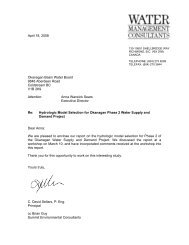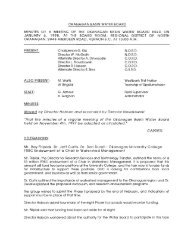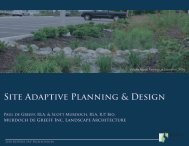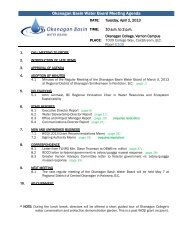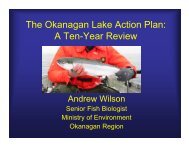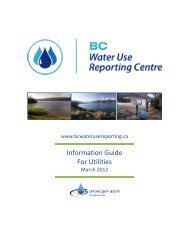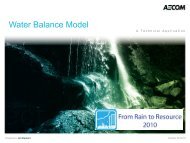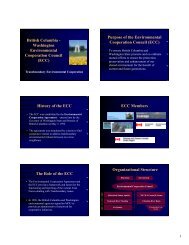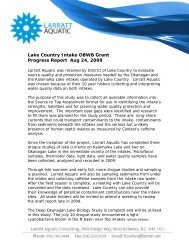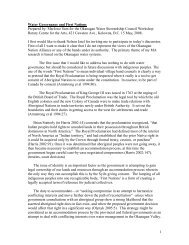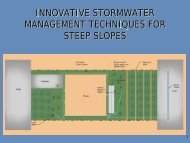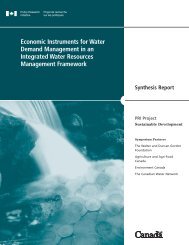Instream Flow Needs Analysis - Okanagan Basin Water Board
Instream Flow Needs Analysis - Okanagan Basin Water Board
Instream Flow Needs Analysis - Okanagan Basin Water Board
- No tags were found...
Create successful ePaper yourself
Turn your PDF publications into a flip-book with our unique Google optimized e-Paper software.
FINAL<strong>Okanagan</strong> <strong>Basin</strong> <strong>Instream</strong> <strong>Flow</strong> <strong>Needs</strong>1.3 Interpretation and appropriate use of guidelinesThis study does not attempt to address value trade-off decisions between fish and other socioeconomicconsiderations. Further, this study was not a field assessment project—we did not determinethrough experimentation and monitoring site and population specific biophysical responses of fishsurvival to flows 2 throughout the <strong>Okanagan</strong> <strong>Basin</strong>. The default flow guidelines in this report, particularlythe British Columbia <strong>Instream</strong> <strong>Flow</strong> <strong>Needs</strong> (BCIFN) guidelines, are known to provide a conservative firstfilter (minimum risk flows, not minimum flows). The BCIFN flow guidelines essentially allow for verylow risk to all fish (Todd Hatfield, pers. comm. 2008). Whether this is too conservative depends onecological objectives and individual values, and what additional information is available to use to makefiner grained recommendations. Rather than the stance: “prove to me that the fish need these flows”, theBCIFN guidelines place the burden to prove that there are no unacceptable deleterious consequences onproponents of water extraction activities. The BCIFN (Hatfield et al. 2003) report clearly states theobjectives behind the flows, and for these objectives the authors and reviewers of the method believe itgenerates a reasonable first filter estimate of minimum risk. Likewise, the strengths and weaknesses ofPHABSIM methods (the backbone of the meta-analysis approach used in this study to provide optimalfish flows (Hatfield and Bruce 2000)), are well documented (Castleberry et al. 1996; Williams 1996). Ifone has different ecological or social objectives or additional and appropriate site specific data, instreamflow results will differ from the default guidelines presented herein. In those cases where the amount ofwater set aside for fish is different (often lower) than these guidelines, a detailed local study (e.g., localhydraulics, biophysical flow-life stage survival assessment) has been performed and/or value trade-offsmade with respect to water licensing, flood protection or power production.Our instream flow guidelines are largely based on needs of fish, especially “sentinel” indicator species(e.g., kokanee, sockeye, rainbow trout). Thus, the instream flow guidelines in this report do not representa true ecosystem assessment for all types of aquatic and riparian organisms. We have however made aneffort to consider how our default guidelines do or do not support the requirements for a number of otherorganisms such as the Rocky Mountain ridgeback mussel, which is listed as a species of concern underCanada’s Species at Risk Act. On the other side of the ledger, because socio-economic flow requirementsare readily available from regulatory authorities and generally are at the forefront of legal agreements(e.g., flood protection, recreational flow needs), our analyses do not document these needs. Where wewere able to acquire water use agreement information related directly to fish flow needs, as in the case of<strong>Okanagan</strong> River, Trout Creek and Mission Creek, we obtained these instream flow targets for comparisonwith the default guidelines generated by our core BCIFN and meta-analysis methods.This report provides a range of different instream flow guidelines. Some of these guidelines differbecause they are the result of different methodologies (e.g., BCIFN minimum risk vs. meta-analysisoptimal flows). Some guidelines differ within a method because they target different ecological objectivesthat should be satisfied at different frequencies (e.g., watershed conservation flows targeting geomorphicchannel maintenance processes 1 in every 5 to 10 years vs. annual minimum instream flows for fish).Some instream flow guidelines are specific to individual species and life-stages. Others are the upper andlower prediction intervals associated with a particular mean prediction, showing more and lessconservative guidelines based on the uncertainty in the underlying data used to generate the meanprediction. Still others represent site specific instream flow recommendations that are either biophysically2 The major exception is the <strong>Okanagan</strong> River mainstem, where guidelines for sockeye salmon egg, fry and smolt survival have been determinedbased on detailed site-specific monitoring and derivation of biophysical fish-flow survival relationships. This work, conducted by the Canadian<strong>Okanagan</strong> <strong>Basin</strong> Technical Working Group (Alexander and Hyatt 2008), and built into the <strong>Okanagan</strong> Fish/<strong>Water</strong> Management Tool (OKFWM;www.ok.fwmt.net), was translated to weekly flow guidelines for purposes of the present study.7 ESSA Technologies Ltd. &Solander Ecological Research



